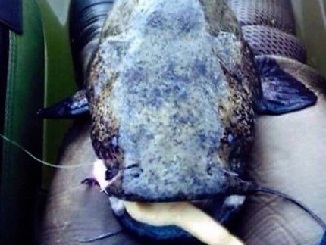 Big Catfish Tip is a series of tips and techniques for catching more catfish. Today’s tip comes from Keith Severns. This first tip reveals a common misconception among anglers and adds a new technique to your catfish arsenal.
Big Catfish Tip is a series of tips and techniques for catching more catfish. Today’s tip comes from Keith Severns. This first tip reveals a common misconception among anglers and adds a new technique to your catfish arsenal.
Flatheads on artificial lures.
The flathead catfish is one amazing predator and no doubt one of the coolest and strongest fish in fresh water. They are incredibly efficient hunters. One of many common misconceptions is that they feed mainly on or towards the bottom – this is way off base! These camouflaged mini-subs hunt the entire water column, even the top, according to Keith. This is just one of many reasons why Keith likes to use artificial lures to intercept and fool these whiskered beasts when they are doing their daily or nightly feeding forays.
Bait shop rumors occasional include a flatty being caught on an artificial. It happens most often when anglers are targeting a different species. Most people refer to the catch as an “accident”, but Keith will tell you that those catches are not accidents. Those catches are incidents, according to Keith, and they can happen all the time for you, just as they have for him.
Benefits of using artificials is being able to use a wide variety of different lure categories and a wide variety of different methods and presentations. The method Keith uses allows you to cover large sections of a waterway and cover all the different zones in the water column. This method helps you unlock the ever changing daily puzzle of figuring out what areas and what depths the fish are using and figuring out what kind of mood they are in.
If they are in a neutral or negative mood (not feeding well), things can be tough, but you can still score by using more finesse techniques. Keith uses drop shotting or vertical jigging with Gulp Eels or Gulp Jerk Shads. Another tactic where artificials shine when fish are inactive is to coax them into feeding using different speeds. High speed/low speed or a pause followed by a fast sweep or banging a lure into and deflecting off of cover may trigger a strike. All of these things mimic an escape maneuver by prey which can often trigger instinctive strikes from predators.
